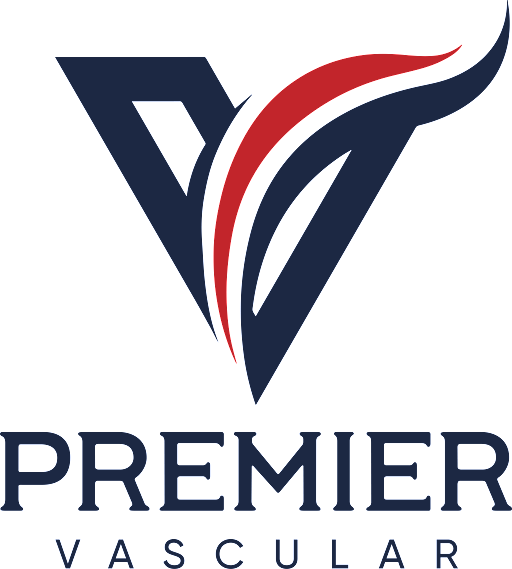Venous Disease / Chronic Venous Insufficiency (CVI)
Tired, swollen, heavy legs? Aching by the end of the day? These could be more than just signs of getting older — they may be early symptoms of chronic venous insufficiency (CVI), a common but progressive condition caused by poor circulation in your leg veins.
At Premier Vascular, our board-certified vascular surgeons diagnose and treat all stages of venous disease — from minor cosmetic concerns to advanced, limb-threatening complications.
Whether you’re just starting to notice symptoms or you’ve been living with leg pain, swelling, or wounds for years, we can help restore comfort and circulation with both minimally invasive and surgical treatment options.
To get started, call the office or book an appointment online today.
What is Venous Disease and CVI?
Venous disease refers to conditions that affect the veins — the blood vessels that return blood to your heart. In your legs, healthy veins have one-way valves that prevent blood from flowing backward.
When these valves become weak or damaged, blood can pool in the lower legs instead of moving upward. This backward flow is called venous reflux, and over time, it leads to chronic venous insufficiency (CVI) — a condition that causes pressure to build up inside the veins.
This pressure causes symptoms like heaviness, swelling, skin changes, varicose veins, and in advanced cases, painful leg ulcers. Without treatment, venous disease tends to worsen over time.
Stages of Venous Disease

Venous disease progresses in stages, classified by the CEAP system:
- C1: Spider veins
- C2: Varicose veins
- C3: Swelling (edema) in the legs or ankles
- C4: Skin thickening, eczema, or dark discoloration
- C5: Healed venous ulcer
- C6: Active venous ulcer (non-healing wound)
Even early stages may signal poor circulation and deserve evaluation.
Venous disease progresses in stages, classified by the CEAP system:
- C1: Spider veins
- C2: Varicose veins
- C3: Swelling (edema) in the legs or ankles
- C4: Skin thickening, eczema, or dark discoloration
- C5: Healed venous ulcer
- C6: Active venous ulcer (non-healing wound)
Even early stages may signal poor circulation and deserve evaluation.
Common Symptoms of CVI
Some people only notice cosmetic changes. Others experience daily discomfort. Symptoms can
include:
- Aching, heavy, or tired legs
- Swelling in the lower legs or ankles
- Bulging, rope-like varicose veins
- Itching, burning, or tingling
- Restless legs or cramps at night
- Skin changes like darkening or hardening
- Open sores that don’t heal (venous ulcers)
Left untreated, skin breakdown can lead to painful wounds and infections that may become limb-threatening.
What Causes CVI?
Chronic venous insufficiency is most often caused by:
- Weakened or faulty vein valves (often hereditary)
- Prior leg injuries or blood clots
- Obesity or pregnancy (increased pressure on veins)
- Prolonged standing or sitting
- Aging and hormonal changes
CVI is especially common in people with a family history of vein disease — but lifestyle factor also play a major role.
How is CVI Diagnosed?
Diagnosis starts with a physical exam and a venous ultrasound, performed in-office. This non-invasive imaging test allows us to see how well blood is flowing through your veins and identify reflux or blockages.
The ultrasound helps determine which veins need treatment and what type of procedure is most appropriate.
Treatment Options for Venous Disease
Treatment plans are tailored to your specific symptoms, anatomy, and goals. Options include:
Conservative Care
- Compression stockings
- Leg elevation
- Medication management
- Weight loss or exercise
- Avoiding long periods of sitting or standing
While helpful for symptom relief, conservative care won’t correct underlying valve damage.
Minimally Invasive Procedures
Performed in-office with little or no downtime:
- Radiofrequency Ablation (RFA): Uses heat to seal the faulty vein
- Endovenous Laser Treatment (EVLT): A laser fiber collapses the vein
- VenaSeal™: A medical adhesive seals the vein shut
- Foam Sclerotherapy: A medicated foam collapses smaller veins
These procedures reroute blood flow to healthy veins and improve both symptoms and appearance.
Surgical Options for Advanced Disease
For patients with severe vein damage, chronic ulcers, or who haven’t responded to less invasive treatments, surgery may be the best option. Our vascular surgeons offer advanced surgical care when needed — always with the goal of preserving your limb and restoring your quality of life.
Why Choose Premier Vascular?
We treat venous disease at its source. At Premier Vascular, you’ll receive expert, individualized care — whether your concerns are cosmetic or complex. Our surgeons offer everything from ultrasound-guided injections to surgical interventions, right here in our outpatient facility.
FAQs About Venous Disease & CVI
What’s the difference between CVI and varicose veins?
Varicose veins are a visible sign of CVI, but CVI includes symptoms like swelling, skin changes, and wounds that go beyond appearance.
Can CVI go away on its own?
No. Valve damage is permanent without treatment, and symptoms typically get worse over time.
Is surgery always necessary?
Not at all. Most patients improve with outpatient procedures. Surgery is only recommended for advanced or complex cases.
Are treatments painful?
Minimally invasive treatments cause little to no pain and require only local anesthesia. Most patients return to normal activities within a day.
Will insurance cover treatment?
Yes — if your symptoms are medical (pain, swelling, ulcers), most insurance plans provide coverage. We’ll help verify your benefits.
What happens after treatment?
Once the diseased vein is closed or removed, blood reroutes through healthy veins. You’ll likely notice a significant improvement in symptoms.
Your legs deserve better. Let’s fix this.
Call Premier Vascular today or book your appointment online to find out what treatment is right for you.

